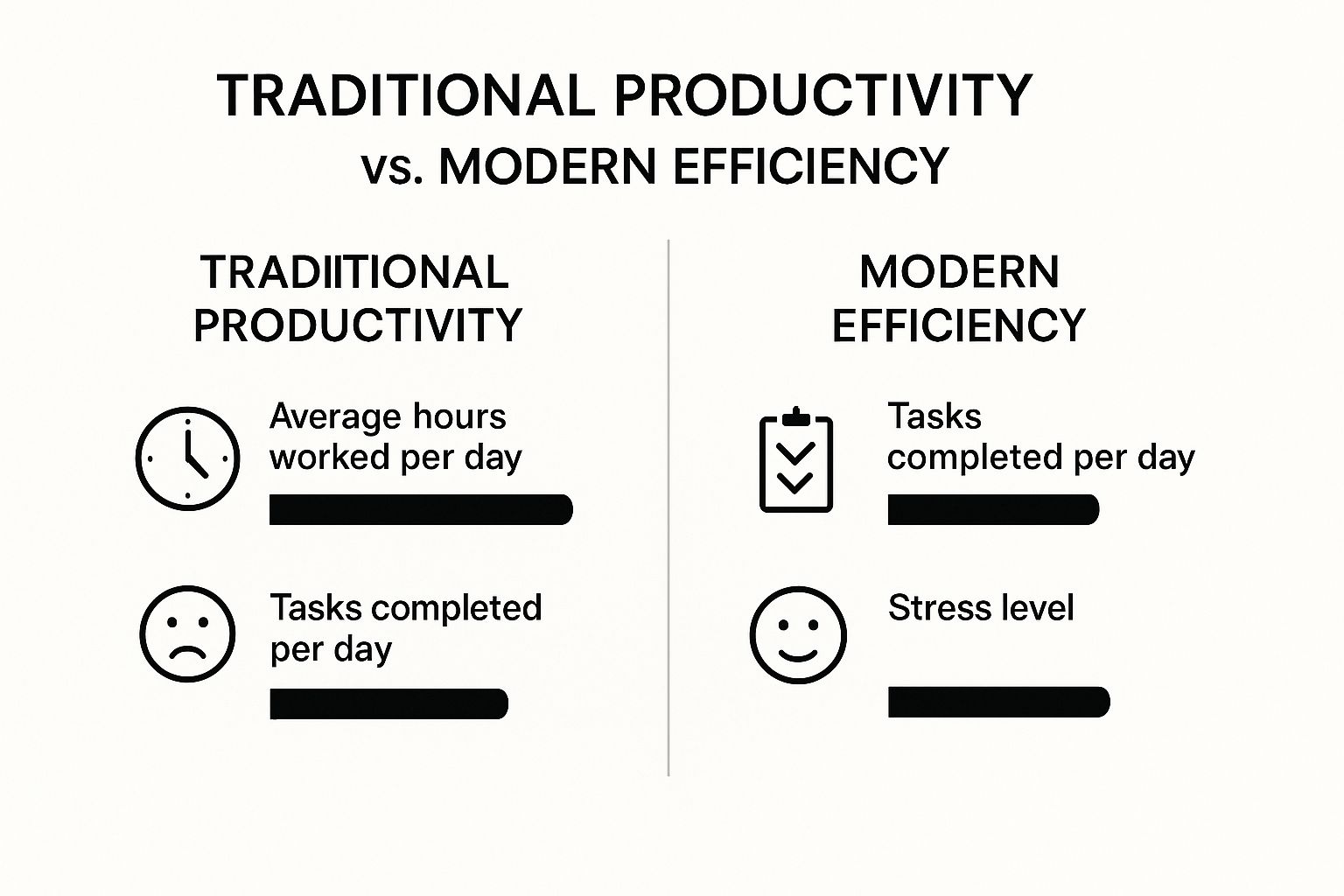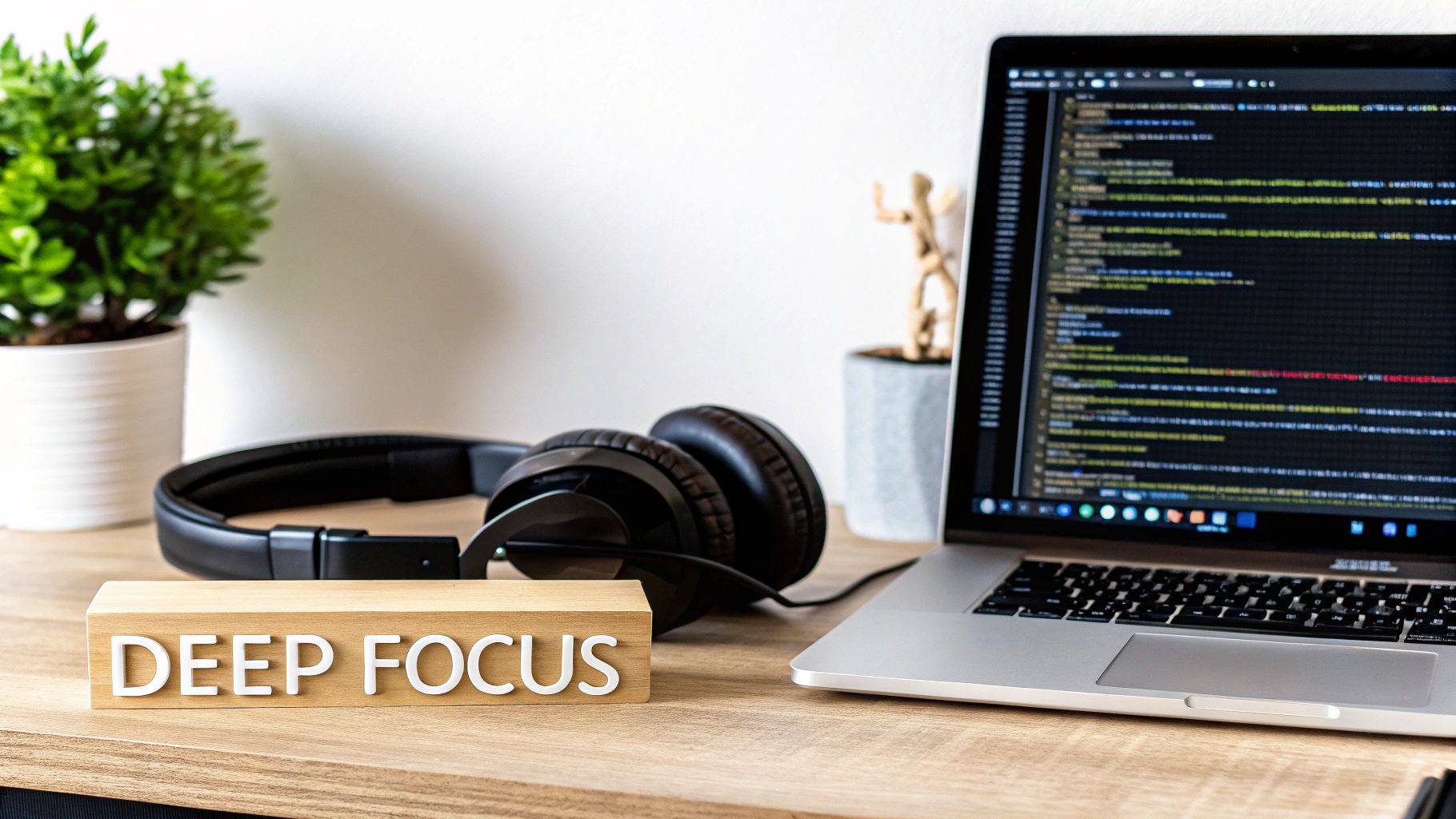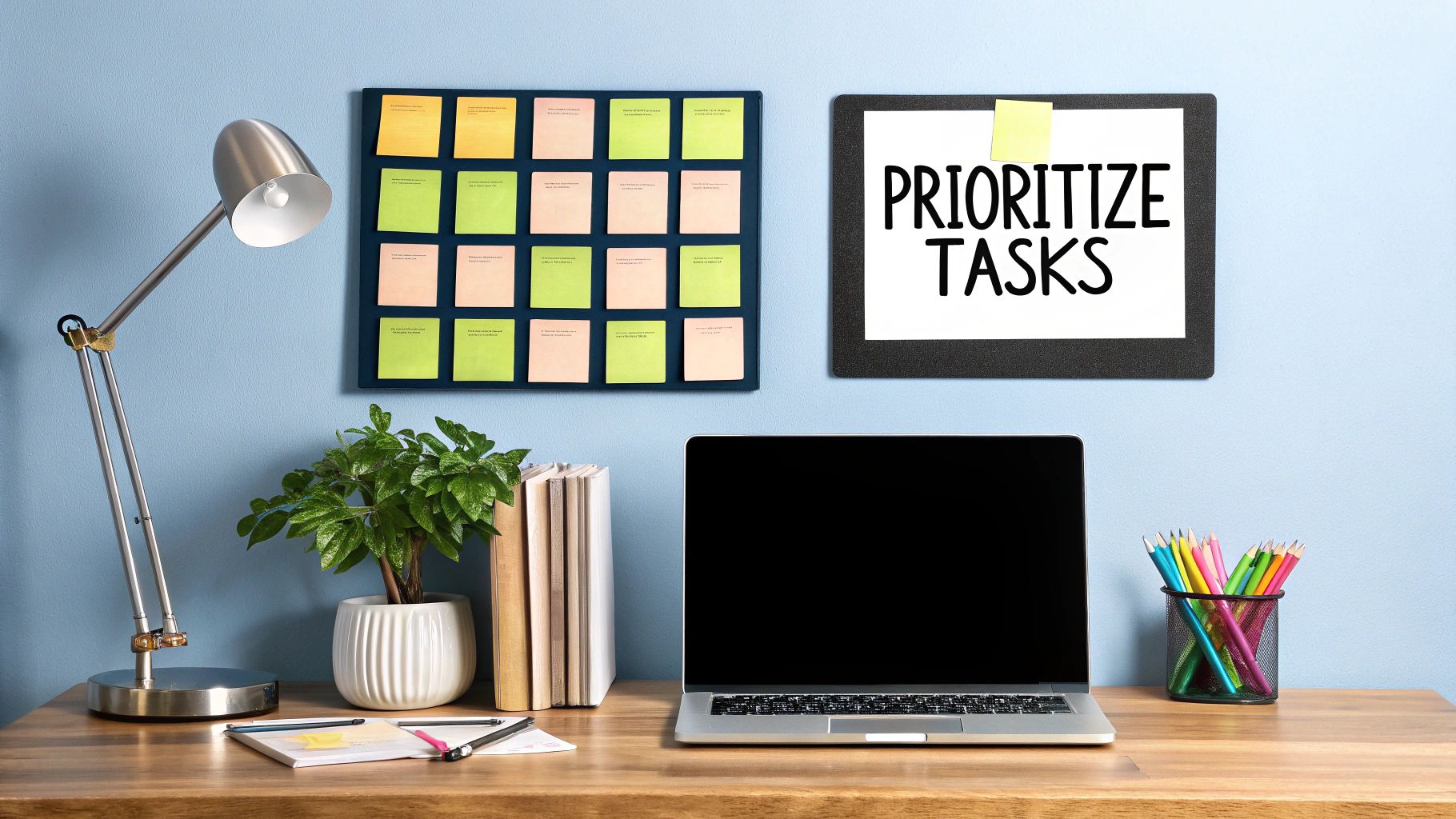How to Increase Work Efficiency and Reclaim Your Day
If you want to genuinely increase your work efficiency, you have to stop counting the hours you put in and start measuring the focused output you achieve. It’s less about applying random productivity hacks and more about designing smarter workflows and mastering the art of deep work. This shift in mindset is what helps you get more done in less time, all while lowering your stress and boosting the quality of your work.
Why Traditional Productivity Hacks Fail
The old nine-to-five grind, where your value was tied to the time you spent at a desk, is completely broken. Let’s be honest, the real challenge today isn’t working longer—it’s protecting your focus from the constant digital noise. Most traditional productivity advice just doesn't get that. It offers surface-level tips that fail to tackle the real reasons we feel so inefficient.
Think about it: many of those outdated strategies were created for a world before constant connectivity. They don’t have an answer for the endless flood of notifications, the last-minute meetings, or the pressure to be online 24/7. What's the result? We spend our days confusing activity with accomplishment, reacting to everyone else's demands instead of making real progress on our own goals. This reactive state is exactly why so many of us feel overworked but completely unproductive.
Shifting From Activity to Achievement
Getting truly efficient isn’t about juggling a dozen tasks at once or having the most perfectly color-coded to-do list. It's about building a system that puts your most important, high-impact work first. This means you need to stop managing your time and start managing your energy and attention.
I've found this new framework rests on three core pillars:
- Mastering Deep Focus: Carving out and fiercely protecting uninterrupted blocks of time for your most demanding tasks.
- Designing Intelligent Workflows: Learning to prioritize tasks based on their actual importance, not just their perceived urgency.
- Using Technology Strategically: Finding tools that automate and speed up your work, rather than just adding another layer of communication.
It might sound counterintuitive, but this approach can actually lead to shorter workdays. Recent data shows the average workday has shrunk by 36 minutes compared to pre-remote work norms, while productivity has actually gone up by 2%. It’s a clear sign that focused, intentional effort beats sheer hours every time. You can dive deeper into these workplace statistics and see how people are reclaiming productive time in their day.
This infographic does a great job of showing the difference between old-school productivity metrics and modern efficiency goals.

As you can see, the modern approach is all about getting more done with less stress, even if it means working fewer hours. It’s about outcomes, not just input.
Master Deep Work in a Distracted World

If you truly want to get more done, you have to learn how to defend your focus. The biggest threat to high-quality work isn't a lack of time—it's the constant flood of interruptions that breaks your concentration into a million tiny pieces. This is why deep work, the ability to focus without distraction on a demanding task, is probably the most valuable skill you can cultivate today.
It's that elusive state of flow where you produce your best stuff in a fraction of the time. But getting there feels harder than ever. We're bombarded. Some workplace disruption findings show that the average employee gets hit with interruptions every two minutes, which can add up to 275 pings a day from chats, emails, and calendar invites. Add in the fact that 60% of meetings are unscheduled, and it's clear our work environments are built for distraction, not concentration.
This relentless context-switching is a massive drain on your mental battery. Every single notification that pulls you away from a task requires significant effort to get your head back in the game.
Time Blocking: Ring Fence Your Most Important Work
The best defense is a good offense. To protect your focus, you need to get proactive and schedule it. That’s where Time Blocking comes into play. Instead of a simple to-do list, you carve out specific chunks of time on your calendar for your most important tasks. This simple shift turns your calendar from a passive record of meetings into a deliberate plan for your day.
Imagine you're a developer tasked with building a complex new feature. Instead of just "hoping" for a quiet moment, you could block out a three-hour session on your calendar labeled "Coding: Feature X." During this time, you create an impenetrable bubble of focus by taking a few key steps:
- Set your Slack status to "Focusing" and mute all notifications.
- Close your email client. Don't just minimize it—shut it down completely.
- Put your phone on silent and move it to another room. Out of sight, out of mind.
This sends a clear signal to your colleagues that you're off-limits for anything non-urgent. More importantly, it reinforces your own commitment to the task at hand.
Common Workplace Distractions and Practical Solutions
It helps to have a clear game plan for the interruptions that pop up most often. Here’s a quick breakdown of common culprits and how to handle them.
| Common Distraction | Impact on Efficiency | Actionable Solution |
|---|---|---|
| Constant Email/Chat Pings | Pulls you out of deep work, creating mental whiplash. | Schedule 2-3 "communication sprints" per day. Keep these apps closed otherwise. |
| "Quick Question" Drop-ins | Derails your train of thought and can turn into a long conversation. | Use headphones (even without music) as a "do not disturb" sign. Suggest a later time. |
| Unscheduled Meetings | Disrupts your planned workflow and breaks your daily rhythm. | Politely decline or reschedule if it's not urgent. Ask for an agenda beforehand. |
| Phone Notifications | Offers an endless scroll of non-work-related dopamine hits. | Turn off non-essential notifications. Keep your phone in a drawer while focusing. |
By anticipating these common interruptions, you can create systems to neutralize them before they hijack your day.
Use Communication Sprints to Stay in Control
Defending your focus doesn’t mean going off-grid and ignoring everyone. It just means you get to control the flow of communication, not the other way around. Instead of reacting to every message the second it arrives, try batching them into dedicated "Communication Sprints."
Key Takeaway: Block out two or three 30-minute slots in your day just for checking and responding to emails and Slack messages. Outside of those sprints, those applications stay closed. This keeps you connected without letting constant pings dictate your day.
When you create an intentional system for both deep work and communication, you dramatically reduce context switching and reclaim the mental space needed for high-value output. This structured approach is a core principle we talk about a lot, and you can find more strategies like these on the https://paraspeech.com/blog. It’s all about creating the right conditions to do your best, most efficient work, day in and day out.
Design a Smart Workflow
 Real productivity isn't about brute force—cramming more hours into the day or juggling a dozen tasks at once. It's about being smarter with your energy and attention. It’s about building a workflow that cuts through the noise and lets you focus on what actually moves the needle.
Real productivity isn't about brute force—cramming more hours into the day or juggling a dozen tasks at once. It's about being smarter with your energy and attention. It’s about building a workflow that cuts through the noise and lets you focus on what actually moves the needle.
Without a system in place, it's all too easy to spend your best hours on low-value "busywork." You know the feeling: you’re busy all day, but at the end of it, the most important projects are still sitting there untouched.
This is why proven frameworks are so valuable. They aren't rigid rules; think of them as mental models to help you decide where to invest your time and focus. By deliberately sorting your tasks, you can make sure your efforts are consistently aimed at the activities that deliver the biggest results.
Sort Urgent from Important
One of the best tools I've ever come across for this is the Eisenhower Matrix. Its power lies in its simplicity: it forces you to distinguish between what’s urgent and what’s important—because they are rarely the same thing.
You sort your tasks into four boxes:
- Do First (Important and Urgent): These are the fires you have to put out. Think critical deadlines, client emergencies, or problems that need immediate attention.
- Schedule (Important but Not Urgent): This is the sweet spot. It’s where strategic thinking, creative projects, relationship building, and long-term planning happen. You should aim to live in this quadrant.
- Delegate (Urgent but Not Important): These are the classic interruptions. Most emails, many meeting requests, and other people's priorities fall here. If you can, hand them off.
- Eliminate (Not Urgent and Not Important): These are the time-wasters. Mindless scrolling, unnecessary meetings, and busywork belong here. Get rid of them.
Let’s look at a real-world scenario. A project manager, Sarah, starts her Monday morning completely overwhelmed. She has a critical project report due Friday (Important, and becoming Urgent), a mountain of emails to clear (Urgent, Not Important), a long-term strategy proposal to outline (Important, Not Urgent), and a stack of industry newsletters to read (Not Urgent, Not Important).
Instead of just diving into her inbox, she applies the matrix. The report is the top priority, but she also carves out a two-hour block on Tuesday afternoon for the strategy proposal. That simple act of sorting turns a chaotic to-do list into an actionable, stress-free plan.
Tackle Your Hardest Task First
Another game-changing technique is "Eat the Frog." The idea is simple but incredibly effective: do your most challenging and important task first thing in the morning. Your "frog" is that one big thing you're most likely to procrastinate on, but it's also the task that will have the biggest positive impact on your day.
By getting your most dreaded task out of the way before anything else, you create a wave of momentum and a sense of accomplishment that propels you through the rest of the day. You’re using your peak mental energy on what matters most, not wasting it on trivial stuff.
For Sarah, the project manager, her "frog" is probably starting the dense data analysis for her report. It’s tough work that requires deep focus. By dedicating her first 90 minutes to it—before even glancing at email or Slack—she makes huge progress while her mind is at its sharpest.
This approach flips procrastination on its head. Instead of having a difficult task hanging over you all day, you conquer it first. This frees up your mental energy and makes everything else feel easier. When you combine frameworks like these, you build a workflow that’s not just about getting things done, but about getting the right things done.
Use Technology to Automate and Speed Things Up

Getting your focus and workflow in order is huge, but the right tech can be a game-changer. Some tools just add another layer of complexity, but the really good ones get rid of the annoying, manual parts of your job so you can focus on the stuff that actually requires your brain.
If a big chunk of your day involves writing—whether you're a developer documenting code or a marketer drafting a campaign—the simple act of typing can be a major speed bump. This is where a tool that fundamentally changes how you work can make a real difference.
Move as Fast as You Think
Think about it: how fast can you speak versus how fast can you type? Most of us speak at around 150 words per minute but type at a measly 40 words per minute. That gap is a massive, often overlooked, opportunity.
Hands-free dictation tools bridge that gap. They let you get ideas down, draft emails, or write reports as fast as you can say them. It's not just about speed, either. It’s about lowering the mental effort of translating a thought into keystrokes. This is especially true on macOS, where purpose-built apps can feel like a native part of the system.
I’ve seen consultants use this to dictate detailed client notes into a report right after a call, capturing little details that would have vanished by the time they sat down to type them out later. A marketing colleague of mine brainstorms entire blog posts just by talking, completely bypassing the "blank page" paralysis.
This approach makes writing feel less like a mechanical chore and more like a natural conversation. It helps you get into that flow state that’s so easily broken by the constant stop-and-start of typing.
A Quick Look at How This Works
For anyone on a Mac, an app like Paraspeech is a great example. It hooks directly into the OS, letting you dictate into any app without fussing with plugins. Whether you're in a code editor, a Google Doc, or a Slack message, you can switch from keyboard to voice without missing a beat.
Here’s a peek at its simple, no-nonsense interface, designed to just work without getting in your way.

The key is that it’s minimal and works everywhere. A productivity tool shouldn't add to your workload; it should lighten it.
It's More Than Just Words-Per-Minute
Adopting a "talk-to-type" workflow has benefits that go way beyond raw speed. It can actually make your entire workday better.
- Less Physical Strain: Let's be honest, typing all day is tough on your hands and wrists. Voice dictation gives them a well-deserved break.
- Beats Writer's Block: Staring at a blinking cursor is intimidating. Just talking feels more natural and can be the push you need to get past a creative hurdle.
- Better "Active" Thinking: You can pace around the room to think or hold a physical document for reference while you're "writing"—things that are impossible when you're tethered to a keyboard.
By bringing a tool like this into your routine, you’re not just typing faster; you’re building a more sustainable and fluid way to get things done. If you're using a Mac with an M-series chip, you can see how Paraspeech feels for yourself and find out if it clicks with your workflow. Picking the right tech is one of the most powerful moves you can make to get more done.
Cultivate an Engaged and Efficient Mindset
You can have the most dialed-in workflow on the planet, but it'll eventually fall apart without the right mindset. Sustainable efficiency isn’t just about the tools you use or the techniques you follow; it’s an inside job. Your own sense of purpose and engagement is the fuel that keeps any high-performance system running.
Productivity tends to follow naturally when you feel connected to your work. But when that connection isn't there, every single task can feel like a slog. This isn’t just a feeling—it has real economic consequences. Public workforce studies regularly show that low engagement is widespread and costly, underscoring how critical engagement is for efficiency.
This just drives home a critical truth: a positive, engaged mindset isn't some "nice-to-have." It’s the very foundation for anyone serious about getting more done efficiently.
Connect Your Work to a Bigger Purpose
One of the quickest ways to fire up your own engagement is to see the bigger picture. It's so easy to get buried in the day-to-day grind and lose sight of why your work actually matters. Take a moment and consciously connect your daily to-do list to a larger goal—maybe it’s a team objective, a company mission, or even your own long-term career aspirations.
For instance, a customer support agent isn't just closing tickets. They are on the front lines, directly shaping customer loyalty and the company's entire reputation. When you frame the work that way, a repetitive task becomes a meaningful contribution.
This simple mental shift can completely change your motivation. Once you truly understand the "why" behind what you do, you unlock a much deeper well of energy and focus.
Key Insight: True efficiency comes from a place of purpose. When you see how your individual efforts contribute to a larger success story, you're more likely to stay focused, overcome challenges, and produce high-quality work without burning out.
From Feedback Loops to Forward Momentum
Whether you're leading a team or just managing your own performance, a system for meaningful feedback is absolutely essential. Vague, infrequent feedback just doesn't move the needle. You need to build clear, consistent, and forward-looking conversations.
I once saw a team lead completely turn around a disengaged group by changing the focus of their weekly meetings. They stopped just listing off tasks and instead focused on two things:
- Celebrating Progress: They kicked off every meeting by highlighting specific wins from the previous week.
- Clearing Roadblocks: They asked, "What's getting in your way, and how can we fix it together?"
That simple change transformed the meeting's entire vibe. It went from a dry status report to a collaborative problem-solving session.
You can do this for yourself, too. Create your own feedback loop by setting clear weekly goals and then doing a quick five-minute review every Friday. Ask yourself what worked, what didn't, and what you can improve for the week ahead. This proactive approach builds momentum and helps cultivate that engaged mindset you need for lasting efficiency.
Common Questions About Boosting Work Efficiency
Putting new productivity strategies into practice is where the rubber meets the road. It’s one thing to read about time blocking, but it's another thing entirely to make it work when your job feels like a constant fire drill. Let's tackle some of the most common questions and roadblocks people run into when they start getting serious about their workflow.
How Long Does It Take to See Results?
You can feel a difference almost immediately with small tweaks. Seriously. Try scheduling a single 90-minute "deep work" session tomorrow morning and watch what happens. The immediate relief of silencing notifications and just focusing is a win in itself.
But for those bigger, workflow-transforming habits? That takes a bit more time and consistency. Think in terms of weeks, not just a day or two. The trick is to not try and boil the ocean. Pick one or two strategies—like the Eisenhower Matrix—and stick with them every single day. Once they become second nature, you'll see a massive, lasting jump in your overall productivity.
A Realistic Timeline: While you'll get small wins right away, give it about a month of consistent effort to truly lock in these new workflows. The goal is for efficiency to become automatic, not something you have to constantly fight for.
What if My Job Requires Me to Be Available All the Time?
This is a big one, especially for folks in customer support, sales, or team leadership. For these kinds of roles, efficiency isn't about disappearing for hours on end; it's about structuring your availability.
Instead of letting every ping and email pull you off task, create dedicated "responsiveness blocks." For example, you could commit to checking and replying to messages for 25 minutes at the top of every hour. The other 35 minutes? That's your protected time for focused work.
Letting your team know about this rhythm helps manage expectations. They'll quickly learn when they can expect a response, and you get to reclaim pockets of concentration throughout the day. It's the best of both worlds.
Is Dictation Really Faster Than Typing?
For most of us, it’s not even close. The average person speaks at around 150 words per minute, but the average typing speed hovers at just 40 words per minute. Even if you're a keyboard wizard, speaking is almost always faster.
This is a game-changer for getting first drafts down, brainstorming ideas, or just plowing through a mountain of emails. Modern tools like Paraspeech for macOS are built for high accuracy, so you're not spending all your time fixing errors. The real magic is capturing your thoughts at the speed they occur, completely bypassing the friction of the keyboard.
And if you ever hit a snag with the setup, you can always find step-by-step guides on the Paraspeech support page to get you sorted out.
Can I Do This if My Team Is Inefficient?
Absolutely. While getting the whole team on board creates a ripple effect, you can still make a huge difference in your own work life. Just focus on what you can control.
- Own your calendar. Use disciplined time blocking to protect your focus.
- Silence your own noise. Close unnecessary tabs and turn off notifications on your devices.
- Optimize your personal workflow. Use tools that speed up your individual tasks.
You might be surprised at the outcome. When people see you consistently getting more done with less stress, it often inspires them to rethink their own habits. You could even start small by suggesting a "no-meeting Wednesday afternoon" to give everyone a chance to catch up. Leading by example is often the most powerful way to shift a team's culture.
Ready to stop typing and start talking? Paraspeech lets you write at the speed of thought, turning your spoken words into text instantly across all your macOS apps. Reclaim your time and boost your output today by visiting https://paraspeech.com.



